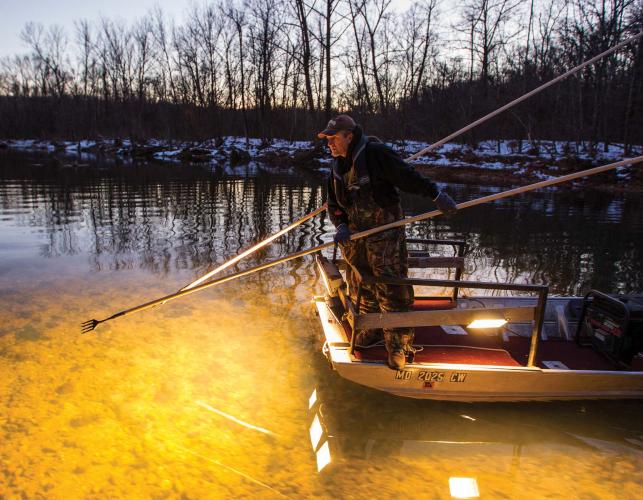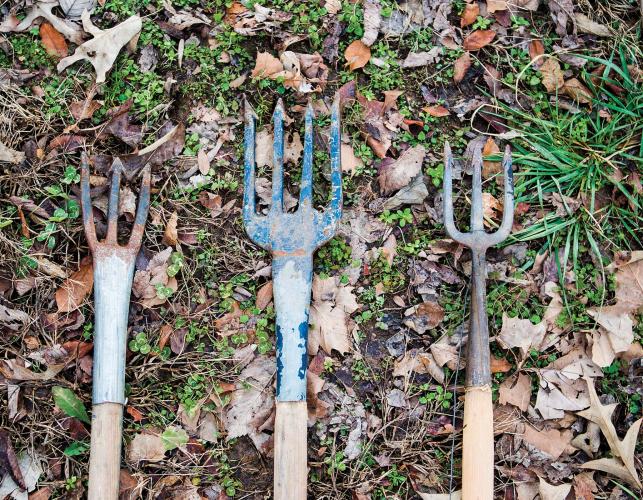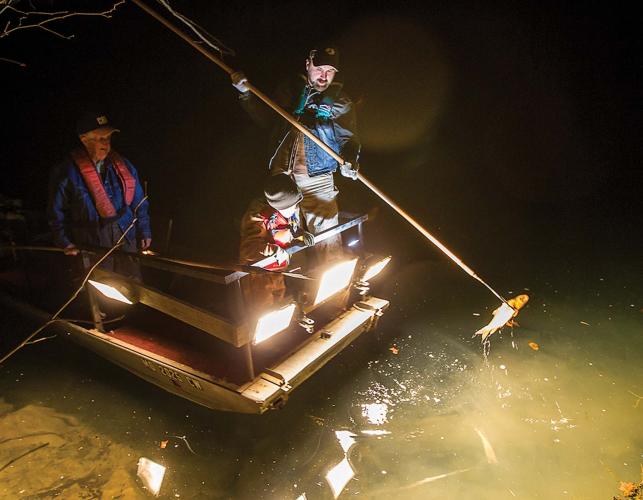In Missouri, the changing of the seasons signals a shift in how we enjoy the outdoors. As winter turns to spring, the crappie start biting, turkeys are gobbling, and Missouri’s fish hatcheries are hosting trout-park openers. The arrival of summer gets Missourians out floating streams, spending time at the lake, and catching catfish. Fall and winter bring deer season, duck hunting, and an Ozark tradition called “gigging.”
Fish gigging is a unique experience born out of necessity and adapted to sport. This rich tradition has become a staple of Ozark living for many. It draws the attention of those outside the Ozarks, and for good reason. There are not many fishing opportunities like it, and it is a heck of a good time! Gigging is an important tradition for many Ozarks residents. The Eleven Point River Anglers Association, based in Alton, Missouri, includes a diverse group of anglers with a long history and deep concern for the Eleven Point River. Their experience and stories contribute to the culture of the area, and they are invested in sharing this exciting sport with the next generation.
What is Fish Gigging?
Gigging consists of spearing fish rather than catching them with a hook and line. It is primarily
a nighttime activity and is most effective in shallow, clear water. Fish harvested by gigging are known generally as “suckers.” They are collected in this manner because traditional angling methods are not effective for catching these species.
Giggers usually stand at the bow of a flat-bottomed boat outfitted with a bright light and a rail to lean upon. They hold their fork-tipped spears over the surface of the rushing water, scanning for fish. Once they spot a sucker, they try to gig it with their spears. It sounds straightforward, but it is challenging. The boat is moving, daylight is gone, it’s cold outside, and the fish are quick.
Necessity Becomes Sport
Fish gigging on the Eleven Point River and throughout the Ozarks began as a necessity. Millard
Barton, 85, a member of the Eleven Point River Anglers Association, remembers a time when getting dinner was not as easy as taking a car ride to the grocery store.
When Millard was a boy, putting food on the table consisted primarily of what his family grew, raised, or hunted. He fondly recalls spending nights with his father, 72 years ago, gigging suckers
to feed his family in the lean winter months.
As the culture and economy of the Ozarks changed, gigging began shifting toward sport. It became a social event and recreation for Ozark families. For local communities, it provided an opportunity to pause and spend quality time with family and friends. Opening night of gigging
season was a major event. Families would show up at boat ramps throughout the Ozarks to gig, fry fish, and socialize. A distinctive sport was born that begins with a cold night on the river and ends with a hot, shared meal.
Fish Gigging Basics
What to Gig
Fish described as “Other Fish” in the Wildlife Code of Missouri are the only fish species that may be taken when gigging. The most common targets are the northern hogsucker and species of redhorse commonly referred to as “yellow suckers.” It is not necessary to differentiate
between the different types of yellow suckers, but it is important to be able to tell a sucker from sport fish like smallmouth bass and walleye. Common gigs used by giggers throughout the
Ozarks. A good gig is an invaluable piece of equipment to own.
Where to Gig
The most popular places for fish gigging are medium-sized rivers in the Ozarks that offer clear water and can be navigated with a flat-bottomed johnboat. Some of the most popular waters to gig are the Current, Eleven Point, Meramec, Gasconade, and James rivers. Once on the water, the boat driver roams the river searching for suckers. Stream shallows offer the best opportunity for gigging success.
Regulations
Gigging season on Ozark streams and rivers runs from Sept. 15 through Jan. 31. The daily limit is 20 fish in the aggregate, and on the Current River from Cedar Grove to the Arkansas line no more than five hogsuckers can be included in the daily limit. See the Wildlife Code of Missouri or contact your local conservation office for more information (see Page 3). Game fish cannot be harvested by gigging. Giggers should verify fish clearly prior to gigging so that game fish are not gigged illegally.
Getting Started
Sign up for a free gigging workshop hosted by the Department of Conservation.
These workshops are held throughout the gigging season. They consist of an introduction
to gigging, a trip on the water, and a fish fry. Contact your local Department of Conservation office for details on upcoming workshops
Equipment
Gigging generally requires a boat, lighting, a gig, and a knowledgeable friend to drive the boat.
Gigging Boat
Prior to modern boats and jet motors, Millard Barton and his father built their first boat out of wood. They would float downstream, steering their motorless boat with poles while they gigged. Most modern gigging boats are equipped with a jet motor and a rail on the bow. Jet motors don’t have a prop — they use an internal impeller that propels the boat by discharging water at a high velocity. The advent of the jet motor helped turn gigging into sport. They made the river more navigable, allowing people to travel up and downstream, even in shallow water.
Lighting
Early giggers were known to burn pine knots in metal baskets for illumination. Millard Barton recalls his first lighting “system,” which was a couple of kerosene lamps fixed to the front of a motorless boat. Today some use floodlights while others fashion reflective housings around bulbs to reflect light into the water. A gas generator usually powers these systems; however, more and more people are installing battery-powered systems that run LED lights. This is not surprising, since eliminating generator noise adds to the evening’s enjoyment.
The Gig
While most aspects of gigging have improved over time, the gig has withstood the test of time. Most gigs have three or four prongs, and the best ones have been forged and tempered by local blacksmiths. A strong gig will last for many years and is an important piece of the tradition. Many giggers have a host of stories that go along with the first gig that was given to them.
Gigging takes practice and patience. Those who have been doing it for years can gig a swimming sucker by throwing the gig like a spear. A skilled gigger like Mark Holman, of the Eleven Point River Anglers Association, makes the sport seem effortless. Years of practice allow him to locate and gig suckers in one fluid motion as the boat moves through the water.
Regardless of whether it is your first or 50th time at the bow, or if you hit your mark, gigging
is a good time and a great social activity. So share in this exciting piece of Ozarks culture and enjoy a unique way to spend time on the river in cooler months.
Preparing Your Catch
Cooking and eating suckers is just as enjoyable as catching them. Cleaning a sucker requires scaling the fish, filleting off the meat, and scoring the fillet. The fillet is then breaded and deep-fried. A sucker fillet has bones within the meat. Scoring and frying the meat dissolves the bones and makes for a delicious meal. A simple and delicious recipe for cooking suckers is:
Ingredients:
- salt
- pepper
- cornmeal (or flour)
- vegetable or peanut oil
- sucker fillets
Cooking:
- Season cornmeal with salt and pepper (add any other spices you like).
- Score fillet (make a series of cuts a quarter-inch apart that are half the thickness of the fillet).
- Roll fillets in cornmeal mix.
- Fry in oil until light brown.
Ingredient substitution: Nadine Barton, of the Eleven Point River Anglers Association, suggests substituting home-rendered hog lard in place of the oil. Her recipe has been perfected through four generations of giggers.












And More...
This Issue's Staff
Managing Editor - vacant
Art Director - Cliff White
Staff Writer/Editor - Brett Dufur
Staff Writer - Jim Low
Photographer - Noppadol Paothong
Photographer - David Stonner
Designer - Stephanie Thurber
Circulation - Laura Scheuler






















